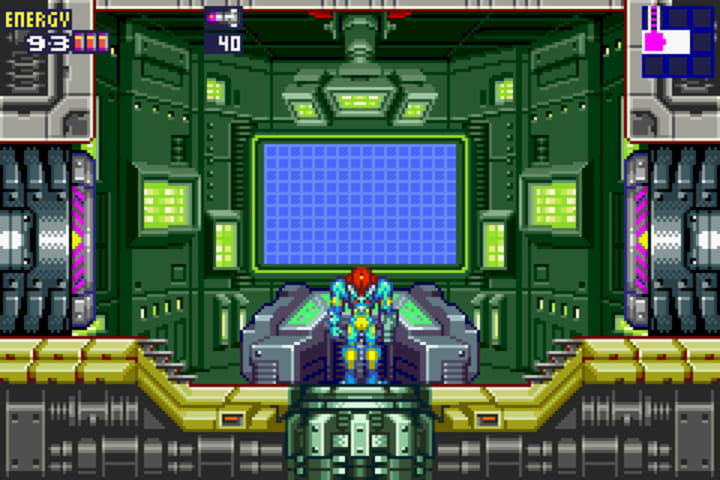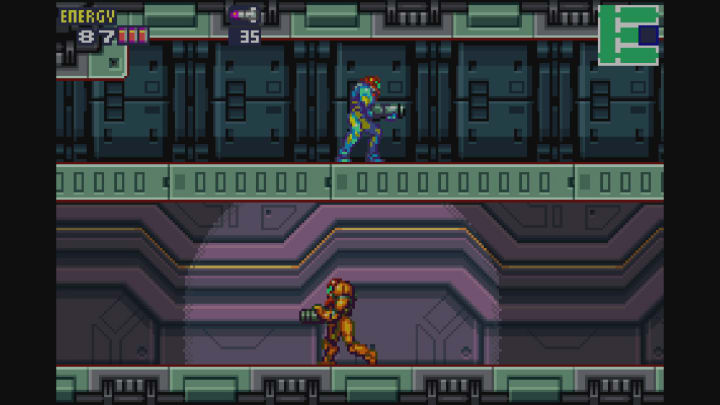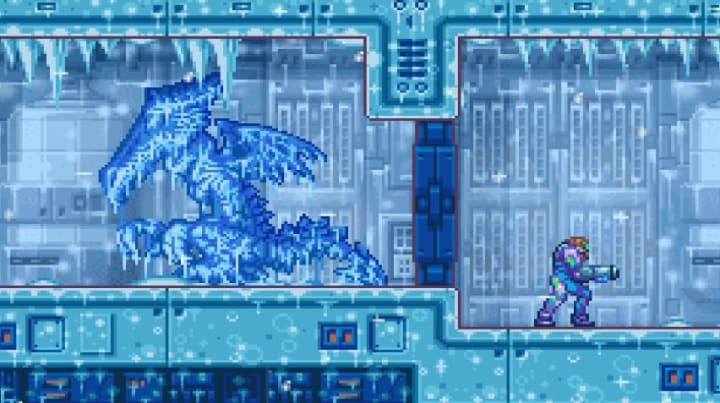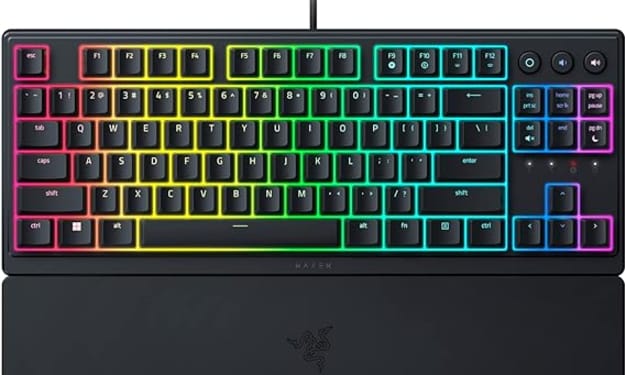Metroid Fusion
Tension Disguised as Real Fear

Okay, it is time for a confession. My first real experience with 2D Metroid ever was Fusion. I had played the original NES game at a friend's house as a kid and I had just finished Metroid Prime around that time and loved it. However, that was the extent of my experience with the franchise. Some time around 2002 a friend of mine sold me his Gameboy Advance, but being a broke college student the only game I had for a long time was Mario Brothers 3. I went to visit my cousin for a week who lived about four hours away and there it was, sitting on a shelf in his living room. I asked him if I could play it while I was there, he said I could keep it. I slotted it into my Crystal Blue GBA, flipped the switch and fell in love instantly with Metroidvanias.

From the title screen the presence of this game is brought into full focus. The opening music is terrifying and as much as people complain about the sound quality of the GBA, this game made full use of the available soundscape to be genuinely scary. Okay maybe scary or terrifying is inaccurate. But the tension at play is easily mistaken for terror and Fusion genuinely thrives on the tension it creates maintaining it throughout the experience and over multiple playthroughs.

One of the principle complaints leveled against Metroid 4 is its linear nature. The player is not given a lot of freedom for sequence breaking, which is often considered a staple of the franchise. But this too is limited for the purpose of ramping up the tension. The narrative of the game also limits the player by design. The obvious reason for this decision is to streamline the gameplay for a portable system. Most people were not going to be able to beat this game in one sitting. The game needed to be designed to empower the player to pick it up and quickly be re-immersed back into the game. Objectives are laid out for you specifically for this reason. But underneath this philosophy of design these decisions further serve the tension. I said Zero Mission could be defined by the word adventure, and I would say Super Metroid's defining word would be intrigue. But Fusion’s focus is tension, which is why it succeeds at it so effectively. The linearity serves the focus and to me turns what others would call a weakness a strength.

The game is rich with detail. On my most recent playthrough I noticed that every few missile shots Samus arm cannon would smoke. I have played the game many times and never noticed it before. Nightmare swooping through the background as you move through Sector 5 is a famous example and sets the stage for similar details present in Samus Returns and Dread. Samus’ suit looks alive which is especially impressive considering the size of her sprite on the tiny GBA screen. The game is more zoomed out than Zero Mission would be and Samus jump is sort of in between Zero Mission and Super Metroid. Faster than Super but slower and more floaty than Zero Mission and to me it is just right. All of the movement and control is streamlined. For example rather than having super and regular missiles be separate, Fusion stacks their effect allowing for an extra sense of progression kind of like the arm cannon upgrades.

The pacing in general is very well done with a nice sense of development being integrated into the narrative. Indeed this is probably the best implementation of the “Samus loses everything and has to get it all back,” trope that is bemoaned by some detractors of the series. It makes sense in the story and you have an ever present reminder of how much Samus has lost in the form of the SA-X. Each encounter with your evil doppelgänger is a nail biting thrill. But progressively you get more and more capable of warding off its attacks until you are just barely on par with its abilities for the final showdown. The story in general is filled with some twists and turns and while there is not anything groundbreaking going on here, there is still plenty of intrigue that once again serves the tension. The SA-X in general is amore memorable antagonist than even dark Samus from the Prime series and anytime you hear those heavy footsteps clunking nearby in the game you pause and take a deep breath.

The game has a sense of cinematography to it as well with the visuals. The close up of the SA-X in the opening comes to mind but even in gameplay there are little flourishes and touches that build up the experience. Sometimes the camera will not pan at the same speed as Samus in certain rooms. It moves slowly and deliberately to maximize the effect of what is revealed. Ridley in the freezer is a great example early but again the game pulls little tricks like this throughout and it is very effective at building mystery and intrigue in the players mind. When the camera slows down the player sits up a little and pays close attention. For a 2D sprite game this was another impressive achievement.

The game is also more difficult than most of the other titles in the series, but not frustratingly so. Bosses are very aggressive and rush the player, sending out attacks with wide coverage. Or some of the bosses will have specific weak points that require the player to assess risk. Zazabi, the second boss is an example, as it jumps around the room it will randomly open its weak spot underneath and descend slowly. The player must run underneath the boss and fire missiles up. But if Zazabi lands on them they take damage. Each time he loses a segment he falls faster. How many shots can you land before you take a hit? A lot of the bosses function in this fashion though Zazabi is probably the simplest to identify. There is a real risk vs reward dynamic made all the more prominent because of the damage enemies can deal. Samus feels more fragile in this game and again in my opinion that serves the narrative and theme yet again.
I really like the backgrounds and color palette of the game. I have noticed it is not to everyone's personal taste, but the brighter colors serve the tiny screen of the GBA well. It also makes sense from a narrative standpoint. The game feels very different from Super Metroid tonally, and a lot of that comes down to this decision. The environments feel more artificial, which is appropriate as the entire game takes place on a space station. The tiny details of the biomes “recreated” for the ship's research tell a story in their own way and drive home how dangerous the X-Parasites are. There is not a single environment they can not invade and by extension thrive in. The only thing immune to them is Samus. Monsters like Serris and Nightmare all were taken over by them. Even Ridley, who was already dead, is resurrected by them and of course the SA-X itself shows that this time Samus herself would also be completely helpless without her new Metroid DNA.

My favorite tune in the game is the one that plays anytime there is a mysterious element at play in the environment or story. It perfectly encapsulates the theme of the game while also displaying a curious intrigue. The soundscape in general really shines in spite of the hardware and the music serves the story perfectly, telling the player how they should feel from moment to moment. My favorite sound effect is the chunky sound that super missiles have when they hit. It really sells how much stronger they are than regular missiles.
You are probably wondering if I have anything negative to say about this game, but honestly I can not think of anything. When taken into context of the hardware and even the franchise the game feels like a perfect subversion of Super Metroid and indeed a worthy follow up. The SA-X has great presence and the X parasites are a worthy successor to the Metroids as the “monster” of the series calling to mind the monster from the Thing in the same way the Metroids called to mind the Aliens that originally inspired the first entry. The story is intriguing and while many people bemoan how often gameplay is interrupted the interruptions are short and help the player remember after long breaks in play where they were in the narrative and where they need to go. I have heard people say that this aspect affects their ability to replay the game but of all the games in the franchise this is the one I replay the most. That may be changing honestly, since I have played Dread twice since its release. But as I have been replaying all these games for these reviews I noticed that Fusion still holds up incredibly well. It is a stellar example of what can be done in spite of the limitations of hardware and screen size as neither of those things feel like they are at play at all in this case. The game is truly underrated and probably the GBA game I have played the most over the years.
About the Creator
Gray Beard Nerd
A nerd who is into cars, video games, movies, book and more. I love to write and hope to share what I have written with others. Please enjoy!!






Comments
There are no comments for this story
Be the first to respond and start the conversation.